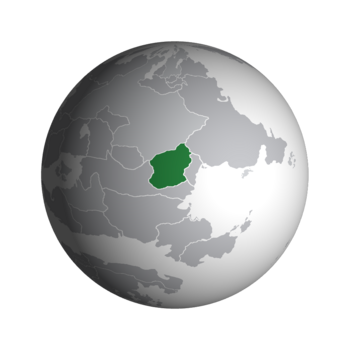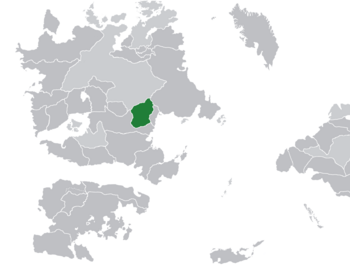Difference between revisions of "Montesayette"
Montesayette (talk | contribs) m |
Montesayette (talk | contribs) m |
||
| Line 110: | Line 110: | ||
'''Montesayette''' ([[Quebecshirite language|Quebecshirite]]: {{Audio|MontesayetteIPA.ogg|/mɔ̃.tɛ.sɛt/|help=no}}), officially the '''Montesayettean Commonwealth''' (Quebecshirite: ''Communauté montesayette'' /kɔmy.nɔ.te mɔ̃.te.sɛt/), is a landlocked country located in [[Ecros]]. It shares borders with [[Terranihil]] to the south and west, [[Majocco]] to the north, and [[Quebecshire]] and [[Eleutherios]] to the east. The country is nominally a federation of [[Provinces of Montesayette|nine provinces]] and one autonomous city, which is the capital and largest city of the country, [[Nerfoy]], but in practice both its [[Government of Montesayette|government]] and its [[Economy of Montesayette|economy]] are highly centralized. It has an estimated population of 65.15 million according to the [[2017 Montesayettean census|2017 census]], of which roughly one-third live in the [[Greater Nerfoy Area]], which includes [[Audrecelles]] and [[Hamicourt]] alongside the capital itself. Other major cities include [[Lavignole]], [[Chenonceaux]] and [[Brumeville]]. | '''Montesayette''' ([[Quebecshirite language|Quebecshirite]]: {{Audio|MontesayetteIPA.ogg|/mɔ̃.tɛ.sɛt/|help=no}}), officially the '''Montesayettean Commonwealth''' (Quebecshirite: ''Communauté montesayette'' /kɔmy.nɔ.te mɔ̃.te.sɛt/), is a landlocked country located in [[Ecros]]. It shares borders with [[Terranihil]] to the south and west, [[Majocco]] to the north, and [[Quebecshire]] and [[Eleutherios]] to the east. The country is nominally a federation of [[Provinces of Montesayette|nine provinces]] and one autonomous city, which is the capital and largest city of the country, [[Nerfoy]], but in practice both its [[Government of Montesayette|government]] and its [[Economy of Montesayette|economy]] are highly centralized. It has an estimated population of 65.15 million according to the [[2017 Montesayettean census|2017 census]], of which roughly one-third live in the [[Greater Nerfoy Area]], which includes [[Audrecelles]] and [[Hamicourt]] alongside the capital itself. Other major cities include [[Lavignole]], [[Chenonceaux]] and [[Brumeville]]. | ||
| + | |||
| + | Under the [[Constitution of Montesayette|1991 constitution]], Montesayette is a federal presidential constitutional republic with a bicameral legislature, the [[National Assembly of Montesayette|National Assembly]]. The country's head of state and head of government is the [[President of Montesayette|president]], who is directly elected to a seven-year term, with no constitutional term limits in place. While the country is a multi-party democracy with free elections, the government under the [[Social Democratic Party (Montesayette)|Social Democratic Party]] (PSD) wields significant control and dominance over politics and society. The PSD has remained in power continuously since 1921, currently holding TBA out of TBA seats in the National Assembly following the [[2023 Montesayettean Senate election|2023 Senate election]]. Montesayette is considered a middle power. It is a member of the [[Terraconserva Council of Nations]], the [[Alliance of Central Ecrosian States]], and the [[Eastern Ecros Free Trade Area]]. | ||
== History == | == History == | ||
Revision as of 08:32, 21 January 2024
Montesayettean Commonwealth Communauté montesayette | |
|---|---|
Motto: Ensemble vers un lendemain meilleur "Together towards a better tomorrow" | |
Location of Montesayette (dark green) | |
| Capital and largest city | Nerfoy |
| Official languages | |
| Recognised regional languages | |
| Ethnic groups (2022) |
|
| Religion (2022) |
|
| Demonym(s) | Montesayettean |
| Government | Federal presidential constitutional republic |
| Hervé Dufriche-Desgenettes | |
| Marielle Bettencourt | |
| Jean-Baptiste Brisbois | |
| Corbin Perreault | |
| Olivie Fabron | |
| Legislature | National Assembly |
| Senate | |
| House of Representatives | |
| Area | |
• Total | 1,743,230 km2 (673,060 sq mi) |
| Population | |
• 2017 census | |
• Density | 39.53/km2 (102.4/sq mi) |
| GDP (nominal) | 2022 estimate |
• Total | |
• Per capita | |
| Gini (2022) | low |
| HDI (2022) | high |
| Currency | Montesayettean pound (MSP) |
| Time zone | AMT-1 |
| Date format | dd-mm-yyyy (CE) |
| Mains electricity | 230 V–50 Hz |
| Driving side | right |
| Calling code | +37 |
| ISO 3166 code | SY |
| Internet TLD | .sy |
Montesayette (Quebecshirite: ![]() /mɔ̃.tɛ.sɛt/), officially the Montesayettean Commonwealth (Quebecshirite: Communauté montesayette /kɔmy.nɔ.te mɔ̃.te.sɛt/), is a landlocked country located in Ecros. It shares borders with Terranihil to the south and west, Majocco to the north, and Quebecshire and Eleutherios to the east. The country is nominally a federation of nine provinces and one autonomous city, which is the capital and largest city of the country, Nerfoy, but in practice both its government and its economy are highly centralized. It has an estimated population of 65.15 million according to the 2017 census, of which roughly one-third live in the Greater Nerfoy Area, which includes Audrecelles and Hamicourt alongside the capital itself. Other major cities include Lavignole, Chenonceaux and Brumeville.
/mɔ̃.tɛ.sɛt/), officially the Montesayettean Commonwealth (Quebecshirite: Communauté montesayette /kɔmy.nɔ.te mɔ̃.te.sɛt/), is a landlocked country located in Ecros. It shares borders with Terranihil to the south and west, Majocco to the north, and Quebecshire and Eleutherios to the east. The country is nominally a federation of nine provinces and one autonomous city, which is the capital and largest city of the country, Nerfoy, but in practice both its government and its economy are highly centralized. It has an estimated population of 65.15 million according to the 2017 census, of which roughly one-third live in the Greater Nerfoy Area, which includes Audrecelles and Hamicourt alongside the capital itself. Other major cities include Lavignole, Chenonceaux and Brumeville.
Under the 1991 constitution, Montesayette is a federal presidential constitutional republic with a bicameral legislature, the National Assembly. The country's head of state and head of government is the president, who is directly elected to a seven-year term, with no constitutional term limits in place. While the country is a multi-party democracy with free elections, the government under the Social Democratic Party (PSD) wields significant control and dominance over politics and society. The PSD has remained in power continuously since 1921, currently holding TBA out of TBA seats in the National Assembly following the 2023 Senate election. Montesayette is considered a middle power. It is a member of the Terraconserva Council of Nations, the Alliance of Central Ecrosian States, and the Eastern Ecros Free Trade Area.



